|
Index
|
|
Kazan Real-Estate Server (Russia)
|
- Within the Old Walls
- The City of London
- The Tower of London
- St Paul's Cathedral
- Historic Westminster
- Called to the Bar
- Trafalgar Square
- Whitehall
- The Houses of Parliament
- Westminster Abbey
- Buckingham Palace
- St James's Palace
- The West End
- A shopper's paradise
- Covent Garden
- Cultural Life
- Art galleries
- Museums
- Theatre & music
- Popular exhibitions
- Parks & Gardens
- Royal parks
- Kew Gardens
- The River Thames
- Greenwich
- Hampton Court
- Pubs and People
|
|
Within the Old Walls
|
|
The City of London
The City of London developed on a most unpromising site, by a dank, mosquito-infested swamp. It was, however, an important crossing point for the Romans over the river Thames and soon became a trading centre. Queen Boudicca and her Iceni tribesmen (from the area now called Norfolk) devastated Londinium in AD 61, but it was soon rebuilt, becoming the capital of the province Britannia, with a splendid basilica (town hall), fine palace, a fort and a temple. Clearly, this was a prosperous colony. It was not until C. AD 200 that the Roman walls were built as a defence, remains of which can still be seen near the Museum of London at 150 London Wall and on the north side of the Tower.
By AD 410 the western part of the Roman Empire had crumbled and troops were withdrawn from England. The town fell into ruins, but by the 9th century was once again flourishing, although under repeated attack by the Vikings.
|
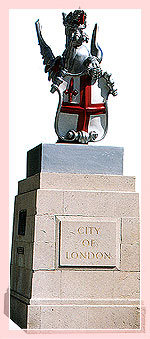
|
|
Armorial gryphon.
|


|
 |
One of the armorial gryphons that mark the limits of the City of London on the main thoroughfares.
|
|
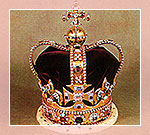
|
|
St Edward`s Crown
|


|
 |
St Edward`s Crown is the earliest sovereign`s crown in existence, being the lineal successor of King Edward the Confessor`s crown. It was made for the coronation of Charles II.
|
|

|
|
Royal Sceptre.
|


|
 |
Among the Crown Jewels is this Royal Sceptre with the cross, bearing the star of Africa, the world`s largest cut diamond.
|
|
|
The Tower of London
In 1066 the Normans invaded and William the Conqueror built a mighty fortress (now known as the White Tower) to subjugate the fierce populace. Richard I 'Coeur de Lion' and later Edward I increased its impregnability by adding the defensive walls with bastion towers. Until the 17th century the Tower served as a fortified royal palace, but it has also accommodated a menagerie, mint, observatory, arsenal, public records and State prisoners over the years. It now contains the Royal Armoury and Crown Jewels.
Visitors are reminded of the grim history of the Tower by the Traitors' Gate, the river entrance through which prisoners passed. Then there is the Bloody Tower where the young princes Edward V and the Duke of York were reputedly murdered by their uncle in c. 1483. Later, Sir Walter Ralegh was imprisoned here for twelve years. Henry VIII had two of his wives executed on Tower Green, Anne Boleyn and Catherine Howard, but perhaps the most pathetic execution here was that of the 'Nine Days Queen', Lady Jane Grey, in 1554.
|

|
|
The keep of the Tower of London.
|


|
 |
The keep of the Tower of London was painted white by Henry III — hence its name 'the White Tower'.
|
|
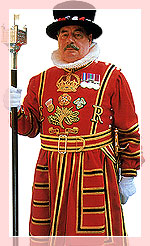
|
|
The Chief Yeoman Warder.
|


|
 |
Formed by Henry VII in 1485, the 'Beefeaters' still wear Tudor dress.
|
|
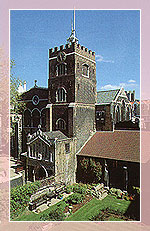
|
|
London's oldest church.
|


|
 |
St Bartholomew-the-Great, London's oldest church, has a Tudor gateway.
|
|
|
St Paul's Cathedral
Crowning Ludgate Hill is this magnificent cathedral, created by Sir Christopher Wren after 1666, when the Great Fire destroyed the previous Norman structure. The splendid dome and ornate baroque bell towers were designed to dominate the City; today, sadly, they vie with unimaginative glass-faced office blocks.
Inside, the view from the west end is awe-inspiring, stretching some 150 metres to the high altar surmounted by an impressive baldacchino. In front, the choir stalls are intricately carved with floral motifs and figures by Wren's contemporary, Grin-ling Gibbons.
The only effigy that was rescued intact from the Old St Paul's was the shrouded figure of John Donne (1573-1631), the most famous Dean, now in the South Choir Aisle. He was an inspired preacher and his writings consisted of profound sermons, as well as passionate love poems.
Above the crossing rises the vast dome, constructed in three sections. The Whispering Gallery encircles it on the inside, where a softly spoken message travels some 34 metres to be clearly heard by a person opposite.
Tombs in the huge crypt (the largest in the world) include those of the Duke of Wellington and Lord Nelson as well as Wren's own. His epitaph reads: Si monumentum requiris, circumspice ('If you seek my monument, look around you').
|
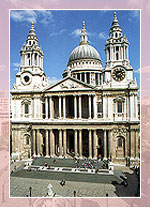
|
|
St Paul's Cathedral.
|


|
 |
The magnificent West Front of St Paul's Cathedral. Wren's dome is topped by a baroque stone lantern and gold ball and cross.
|
|

|
|
St Paul's Cathedral.
|


|
 |
New buildings now outnumber the old in the City of London, but the dome of St Paul's still retains its grandeur.
|
|
|
Historic Westminster
|
|
Called to the Bar
Linking the City of London and Westminster are Fleet Street and the Strand, where the neo-Gothic pile of the Royal Courts of Justice (generally called 'the Law Courts') stands, designed by G. E. Street and completed in 1882. This is distinct from the Central Criminal Court, the 'Old Bailey' in the City, built on the site of the notorious Newgate Prison. At the beginning of Sessions and on State occasions, judges still carry posies of sweet herbs and flowers, a reminder of the stench and fevers associated with the old gaol.
Away from the hubbub of Fleet Street and High Holborn are the four Inns of Court, whose leafy quadrangles offer a peaceful retreat for busy office workers. These have traditionally provided lodgings for barristers and law students since the 14th century. Lincoln's Inn Old Hall dates from 1492, vaunting a fine collarbeam roof and 16th-century linenfold panelling. It is in the Middle Temple Hall that students are 'called to the Bar' after passing their finals. Shakespeare's Twelfth Night was performed here in 1601. Within the precincts of the Inner Temple is the round church of St Mary built by the Knights Templar in the 12th century.
|
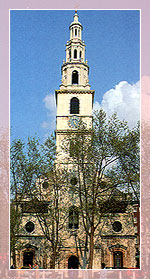
|
|
Wren church.
|


|
 |
This Wren church, St Clement Danes in the Strand (c. 1680), contains the bells immortalised in the nursery rhyme 'Oranges and Lemons'.
|
|
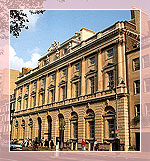
|
|
Somerset House.
|


|
 |
Somerset House is a fine edifice on the Strand, designed by Sir William Chambers in 1776 for government offices. It now houses the Courtauld Institute Galleries.
|
|

|
|
Admiralty Arch.
|


|
 |
Admiralty Arch at the end of The Mall was constructed in 1910 to Sir Aston Webb's design in memory of Queen Victoria.
|
|
|
Trafalgar Square
Popular with both political demonstrators and tourists, Trafalgar Square is dominated by the monument to England's greatest naval hero, Admiral Lord Nelson. On the north side is the National Gallery and to the east the graceful St Martin-in-the-Fields church designed by the Scottish architect James Gibbs in 1726.
|

|
|
Trafalgar Square.
|


|
 |
Dominating Trafalgar Square is the 170-ft (52-m) granite column bearing the statue of Admiral Lord Nelson. His major battles are depicted in bronze reliefs on the podium.
|
|
|
Whitehall
This is the street that leaves Trafalgar Square on the south side, leading the way to the centre of British government in Parliament Square. The most notable building here is Inigo Jones's Banqueting House of 1622, built in perfectly proportioned Palladian style. The Saloon has an elaborate ceiling painted by Rubens, that depicts, amid numerous cherubs (each of which is more than 3 metres tall), the blessings of wise rule. It was from a window here that King Charles I walked on to the scaffold to die 'the martyr of the people'.
Opposite is Horse Guards, an attractive 18th-century building with clock tower, where the colourful ceremony of Guard Mounting can generally be seen in the mornings. Behind, on Horse Guards Parade, the spectacle of Trooping the Colour, takes place each year in June.
|
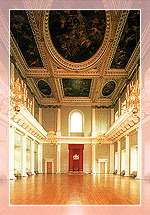
|
|
Whitehall Palace.
|


|
 |
Last surviving part of the old Whitehall Palace is the Banqueting House, which has a stone balustrade from where the king's subjects could watch their sovereign dine.
|
|
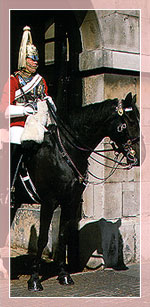
|
|
Household Cavalry.
|


|
 |
One of the two mounted troopers of the Household Cavalry posted daily at Horse Guards.
|
|
|
The Houses of Parliament
Built by Charles Barry and August Pugin in flamboyant neo-Gothic style between 1837 and 1860, the Houses of Parliament provide chambers, lobbies and offices for politicians, linked by some two miles (3.2 km) of passages. In the House of Commons, the Speaker presides over debates, the Government and Opposition facing each other over the despatch boxes, with Ministers on the front benches. Bills are passed from here to the House of Lords, where some are amended.
The Houses of Parliament are often referred to as the Palace of Westminster, having been constructed on the site of the home of monarchs from Edward I toHenry VIII. The old palace was destroyed in a calamitous fire in 1834, leaving only the medieval Westminster Hall, the cloister and undercroft of St Stephen's Chapel, and the moated Jewel Tower built by Edward III in 1366 for his treasures. Westminster Hall, scene of many extravagant royal celebrations including coronation banquets, is dominated by a massive hammerbeam angel roof.
The much-photographed Big Ben in St Stephen's Tower is actually the name of the huge 13 1/2-ton (13*7-tonne) bell that strikes the hours. Old pennies are used to adjust the clock's mechanism, helping it to keep in perfect time. The minute hands on each of the four dials are as high as a double-decker bus.
|
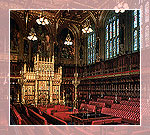
|
|
Lords Chamber.
|


|
 |
The dramatic Lords Chamber with Pugin's elaborate throne at the end and the Lord Chancellor's woolsack in front.
|
|
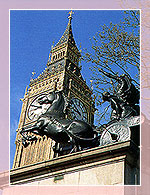
|
|
Queen Boudicca and her daughters.
|


|
 |
Cast in bronze are the valiant Queen Boudicca and her daughters riding in a chariot (Thomas Thornycroft, 1850s). Big Ben towers over them.
|
|
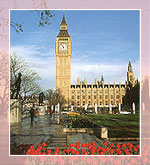
|
|
Parliament Square.
|


|
 |
Parliament Square was laid out by Sir Charles Barry in 1868. Statues of famous statesmen and soldiers line its pavements, including Disraeli, Field-Marshal Smuts and Winston Churchill.
|
|
|
Westminster Abbey
Founded by Edward the Confessor and consecrated in 1065, Westminster Abbey has seen the coronation of every monarch since William I (the Conqueror), with the exception of Edward V and Edward VIII, and thus has always been at the centre of the country's history. It was also the burial place of all English kings and queens until George III.
In 1245 Henry III began a rebuilding programme which was continued over three centuries by successive monarchs, faithfully adhering to Henry de Reyns' original design with its soaring nave supported by flying buttresses, radiating chapels from the apse and rose windows in the transepts. The finest example of Tudor stonework can be seen in Henry VII's chapel, where the fan-vaulting is carved with a cobweb-like delicacy. Nicholas Hawksmoor added the 225-ft (69-m) twin towers in the mid-18th century.
In addition to the royal tombs, visitors usually head for Poets' Corner, where there are numerous memorials to the famous from Chaucer to Laurence Olivier. The tomb of the Unknown Warrior, marked by a black marble slab in the floor, is a poignant reminder of the appalling loss of life during World War I.
|
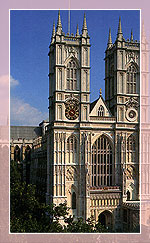
|
|
Westminster Abbey.
|


|
 |
Westminster Abbey's true name is the Collegiate Church of St Peter in Westminster. It expresses the spirit of French Gothic architecture.
|
|
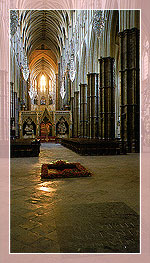
|
|
Memorial to Winston Churchill and tomb of the Unknown Warrior.
|


|
 |
The nave looking east, with the memorial to Winston Churchill and tomb of the Unknown Warrior in the foreground.
|
|
|
Buckingham Palace
It was George IV's idea to turn Buckingham House, his parents' home, into an imposing residence fit for the king of England. In the face of much criticism, John Nash undertook the remodelling and extension at vast public expense, and it all took so long that neither George IV nor his brother William IV ever lived there. Queen Victoria, however, loved Buckingham Palace (even though many of the 1,000 windows would not open, doors were ill-fitting, lavatories were unventilated and bells did not ring!). Edward Blore finally finished it satisfactorily in 1847.
Many of the State rooms are sumptuously grand, notably the White Drawing Room, the domed Music Room with its 18 columns of deep blue scagliola, and the State Dining Room decorated in vivid crimson. The Royal Family occupies relatively few of the 600 rooms, many of which provide offices and accommodation for members of the Royal Household.
Nearly every morning London's most popular ceremony, The Changing of the Guard, takes place on the forecourt, much to the delight of the assembled crowd.
The Queen's Gallery, showing art treasures from the Royal Collection, is open to the public. Further down Buckingham Palace Road is the Royal Mews, where The Queen's Horses and Carriages can be seen mid-week.
|

|
|
State Opening of Parliament.
|


|
 |
The Queen in the Australian State Coach on her way to the State Opening of Parliament in 1988. The coach was a gift from the people of Australia to celebrate their bi-centenary, and this is the first time it was used.
|
|

|
|
The East Wing of Buckingham Palace.
|


|
 |
The East Wing of Buckingham Palace, which incorporates the famous balcony, was refaced in Portland stone by A. Webb in 1913. He also envisaged the Queen Victoria Memorial seen in front.
|
|

|
|
Handed over the Palace keys.
|


|
 |
Having handed over the Palace keys in a symbolic ceremony, the Old Guard marches away to the stirring music of the Regimental Band.
|
|
|
St James's Palace
Henry VIII built this 'fayre mansion' of red brick on the site of a leper hospital. The turreted gatehouse still provides an imposing entrance to the palace, which now houses offices of the Prince and Princess of Wales. Heads of State and diplomats are received in the State rooms and it is from Friary Court that the proclamation of a new sovereign is made.
Several monarchs were born in the palace, including Charles II, who commissioned Sir Christopher Wren to add some fine State Apartments overlooking the park.
The Old Guard marches from here to Buckingham Palace most mornings, providing a colourful spectacle for passers-by.
|
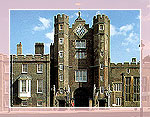
|
|
St James's Palace.
|


|
 |
Carved over the doors of the Tudor gatehouse of St James's Palace are the initials of Henry VIII and Anne Boleyn.
|
|
|
The West End
|
|
A shopper's paradise
Piccadilly Circus is regarded as the hub of the West End, and streets that radiate from it, notably Shaftesbury Avenue and the Haymarket, are renowned for their theatres. In the centre of the Circus is the winged statue of Eros representing the Angel of Christian Charity.
The handsome curve of Regent Street, laid out in 1813-20 by the architect John Nash, leads up to Oxford Street which contains most of the big department stores such as Selfridges and Debenhams. Marks & Spencer at number 458 offers a wide selection of well-made good-value clothing.
Many of the most exclusive shops, especially jewellers and art dealers, arc to be found in Bond Street, which leads down into the heart of Mayfair, home of the rich.
|

|
|
Piccadilly Circus.
|


|
 |
Red buses, taxis and brightly coloured advertisements are all familiar sights around busy Piccadilly Circus. The name derives from a 17th-century ruff called a 'piccadil'.
|
|
|
Covent Garden
Until 1974 there had been a fruit and vegetable market in Covent Garden for more than 300 years, but traffic congestion eventually prompted its relocation to Nine Elms near Vauxhall. Now Charles Fowler's Market building of the early 1830s is subdivided into attractive small shops with stalls and cafes in the thoroughfares. In the old Flower Market are the Theatre Museum and the London Transport Museum which includes a horse-drawn bus and the first steam-powered underground train. Street entertainers contribute to the festive atmosphere of Covent Garden, often using the classical portico of Inigo Jones's St Paul's Church as a backdrop.
In the evenings, ballet and opera lovers assemble at the Royal Opera House, elegantly designed by E. M. Barry in 1858 with more recent extensions.
|
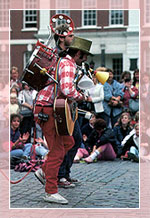
|
|
One-man band.
|


|
 |
A one-man band amuses both Londoners and tourists at Covent Garden.
|
|
|
Cultural Life
|
|
Art galleries
The most important collection of historical paintings in the UK is housed at the National Gallery in Trafalgar Square, which covers the major European schools since the 13th century. Next door, the National Portrait Gallery provides an exhaustive review of the most eminent Britons from Henry VII to the Beatles. Evocative scenes by great British painters such as Gainsborough, Constable and Turner are in the permanent collection at the Royal Academy of Arts in Piccadilly, which also shows major loan exhibitions each year. The full extent of Turner's genius can be appreciated in the new Clore Gallery at the Tate, Millbank. This gallery holds national collections of British and modern foreign art.
|
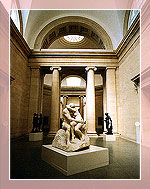
|
|
Tate Gallery.
|


|
 |
Sculptures as well as paintings are on show at the Tate Gallery.
|
|
|
Museums
The group of four museums in South Kensington evolved from the vision of Prince Albert, Queen Victoria's consort, after the Great Exhibition of 1851. In the Victoria and Albert Museum in Exhibition Road the chief glory is the collection of antique furniture, but along the 7 miles (11 km) of galleries all aspects of the decorative arts can be appreciated. Opposite, in the Science Museum, visitors enjoy the spectacle of early steam engines as well as the Apollo 10 space capsule. Round the corner is the Natural History Museum, incorporating the Geological Museum.
The most comprehensive collection of antiquities is to be found at the British Museum in Great Russell Street, while the capital's history is visually represented at the Museum of London in the City.
|
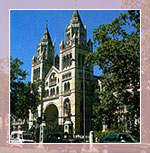
|
|
Natural History Museum.
|


|
 |
The cathedral-like terracotta construction of the Natural History Museum, opened in 1881, is a fitting repository for the wonders of creation. Here, children gaze in fascination at both creepy-crawlies and monstrous dinosaurs.
|
|
|
Theatre & music
London's theatreland is justifiably world-famous, ranging from spectacular musicals, frothy comedies and 'who-dun-its' to experimental 'fringe' shows and the best of classical drama. Many of the West End playhouses are charming, with whimsical Victorian interiors featuring ornate boxes and balconies.
At the other extreme is the Barbican Centre for Arts and Conferences in the City, opened in 1982, where classical music can be heard daily in the stylish modern concert hall.
From July to September, the largest musical festival anywhere takes place at the Royal Albert Hall in Kensington Gore. Affectionately called 'The Proms', the BBC Henry Wood Promenade Concerts offer a wide variety of classical and contemporary music.
|
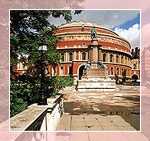
|
|
Royal Albert Hall.
|


|
 |
Oval in shape, the acoustics of the Royal Albert Hall were recently improved by hanging saucer-like shapes from the roof. It holds more than 7,000 spectators.
|
|
|
Popular exhibitions
For a spine-chilling experience of the bloodiest events of British history, the London Dungeon in Tooley Street is recommended, and to find out who was the fastest, fattest, tallest and so on, the Guinness World of Records at Piccadilly Circus supplies the answers.
Wax effigies of the world's best-loved heroes and heroines, as well as the most hated politicians and scoundrels, can be viewed at Madame Tussaud's. By way of contrast, visitors can recline in an easy chair and gaze at the habits of planets and stars in the London Planetarium. Both are in the same building in Marylebone Road.
|

|
|
Madame Tussaud's.
|


|
 |
Lifelike wax effigies of Henry VIII and his six wives are on display at Madame Tussaud's along with many other famous characters.
|
|

|
|
London Planetarium.
|


|
 |
The wonders of the solar system can be explored from the comforts of an easy chair at the London Planetarium.
|
|
|
Parks & Gardens
|
|
Royal parks
The most ancient of the central-London royal parks is St James's, having been originally a nursery for Henry VIII's deer along with a tilt-yard (for jousting) and bowling alley. The beauty of its layout today is largely due to John Nash who remodelled it in 1828. Particularly lovely is the view across the lake through the weeping willows to the pinnacles and domes of Whitehall.
Across The Mall is Green Park, which in the past was a favourite place for duellists and highwaymen. Today office workers can enjoy a peaceful picnic lunch under the dappled shade of the plane trees.
Merging almost imperceptibly with Hyde Park are Kensington Gardens, although these are more formal in style with Kensington Palace as the focal point. Speakers' Corner near Marble Arch draws the crowds. Here anyone with a loud enough voice can declaim on every subject imaginable. The islands on the Serpentine are a haven for breeding waterfowl, while the lake itself is popular with rowers. Along Rotten Row horseriders are a familiar sight.
John Nash also left his mark on Regent's Park, under the instructions of the Prince Regent. The Inner Circle contains Queen Mary's Garden which in summer is filled with the perfume of some 20,000 rose bushes. Perhaps the park is at its best in spring, when hundreds of flowering trees are fully in bloom.
Many visitors head for the zoo, home to more than 12,000 animals including hand-reared Rosie the rhino. Animal feeding times involve much hilarity.
|
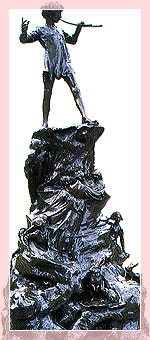
|
|
Peter Pan.
|


|
 |
J. M. Barrie's Peter Pan, eternally youthful, stands by The Long Water in Kensington Gardens, the setting for much of this magical story.
|
|

|
|
London Zoo.
|


|
 |
A rhinoceros provides much interest at the London Zoo in Regent's Park.
|
|
|
Kew Gardens
The Royal Botanic Gardens at Kew are a delight for plant lovers. Although their purpose is primarily scientific, the flowerbeds are pleasingly laid out. The hot houses are a special attraction, where tropical trees, orchids and other exotic plants can be admired as much for their strangeness as for their beauty.
|
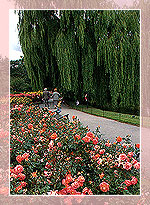
|
|
Regent's Park.
|


|
 |
Regent's Park has a glorious display of blooms from early spring until late autumn.
|
|
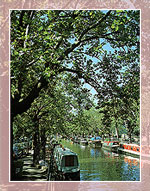
|
|
Regent's Park Canal.
|


|
 |
Regent's Park Canal joins up with Grand Junction Canal at Paddington Basin and eventually reaches the Thames by way of east London. The best way to appreciate the attractive stretch running through Regent's Park is to take the pleasure-boat from Camden Lock to Little Venice via the zoo.
|
|
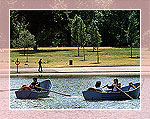
|
|
Serpentine Lake.
|


|
 |
A small tributary of the Thames was dammed to form the Serpentine Lake, undoubtedly the main feature of Hyde Park. Visitors can spend a relaxing hour or two rowing on the lake.
|
|
|
The River Thames
|
|
The best way to see the Thames is undoubtedly from one of the many pleasure boats that leave from Westminster, Charing Cross or Tower piers. Travelling upstream, the grandeur of the Houses of Parliament and Lambeth Palace gives way to the solid edifice of Battersea Power Station that glowers over the cheerful cluster of Chelsea houseboats. In the other direction, the Tower of London is the most impressive sight.
Between the Tower and Hampton Court there are 32 bridges, some constructed of uninspiring modern concrete, and others displaying intricate Victorian ironwork, such as the Albert Bridge that leads over to Battersea Park. Tower Bridge, whose walkways are open to the public providing spectacular river views,is the most photographed of them all.
Nearby is HMS Belfast, a battleship surviving from World War II, now a museum. Gun decks, engine rooms and sick bay can all be explored.
Adjacent to the Tower is the old St Katharine's Dock, tastefully transformed into a marina, where visitors can relax and eat or drink while surveying modern yachts and historic ships bobbing on the water.
A trip further down river on the brightly painted Docklands Light Railway takes in the most amazing modern development imaginable, where chic converted warehouses mingle with high-tech office blocks and waterside shopping precincts. The Isle of Dogs boasts some unusual constructions, such as the Daily Telegraph Building and the London Arena, the pop and sports venue, with seating for 12,000.
|
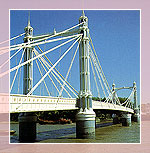
|
|
Albert Bridge.
|


|
 |
Albert Bridge has a unique construction, being part suspension. Reinforcement was necessary in the 1970s to cope with the demands of modern traffic.
|
|
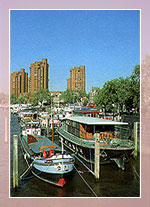
|
|
Community of houseboats.
|


|
 |
Huddled under Cheyne Walk is this community of houseboats. Former punts and barges have been converted into comfortable floating homes.
|
|

|
|
Cleopatra's Needle.
|


|
 |
An interesting feature of Victoria Embankment is Cleopatra's Needle, some 3,500 years old, brought from Egypt in 1878. Dedicated to Pharaoh Tethmosis III, the names of Rameses II and Cleopatra were added later.
|
|
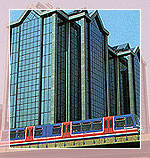
|
|
Docklands Light Railway.
|


|
 |
The Docklands Light Railway provides a speedy link between Tower Hill or Stratford and Island Gardens.
|
|
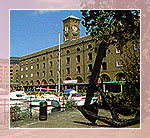
|
|
St Katharine's Dock.
|


|
 |
St Katharine's Dock was constructed by Thomas Тelford in 1828.
|
|
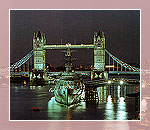
|
|
Battleship HMS Belfast and Tower Bridge.
|


|
 |
Two major tourist attractions — the battleship HMS Belfast and Tower Bridge beyond.
|
|
|
Greenwich
There are regular boat trips to Greenwich, a former port, where tourists are greeted with the elegant lines of Wren's naval hospital (later the Royal Naval College) framing the lovely Queen's House designed by Inigo Jones in classical style. This now forms part of the National Maritime Museum. Behind, crowning Flamsteed Hill, is the Old Royal Observatory founded by Charles II in 1675, where, two centuries later, the Prime Meridian of the world was established.
Nearby, the fastest tea and wool clipper, the Cutty Sark of 1869, is preserved in dry dock. Next to it is the heroic little Gipsy Moth IV which took Sir Francis Chichester around the world.
|
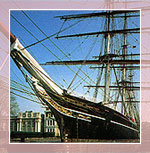
|
|
Cutty Sark.
|


|
 |
Visitors can explore the Cutty Sark above and below decks and admire its striking collection of figureheads.
|
|
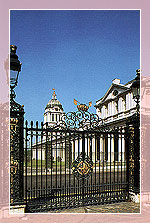
|
|
Royal Naval College.
|


|
 |
Officers train here at the Royal Naval College, so only the Painted Hall and Chapel are open to the public.
|
|

|
|
Queen's House.
|


|
 |
Begun in 1616, the Queen's House was intended for James I's wife, Anne of Denmark.
|
|
|
Hampton Court
Summer boat trips upstream take passengers to this magnificent Tudor palace, built by Cardinal Wolsey to incorporate 1,000 opulently decorated rooms. He 'presented' it to Henry VIII, who envied this lavish display of wealth and power. Catherine Howard's ghost, still crying for mercy, is believed to haunt the Long Gallery.
Wren later remodelled the palace and gardens, and his State Apartments can be appreciated for their warm dignity. Getting lost in the maze is part of the fun of a visit to Hampton Court.
|

|
|
Hampton Court Palace.
|


|
 |
The West Front of Hampton Court Palace, with its splendid Great Gatehouse, built during Henry VlII's reign. Heraldic beasts flank the causeway.
|
|

|
|
Pond Garden.
|


|
 |
To the south of Wolsey's Clock Court is the Pond Garden, which was laid out c. 1700 and re-planned some 200 years later. Adjoining Clock Court is the South Front (on the right of the photograph) which overlooks the Privy Garden. Sir Christopher Wren designed this part of Hampton Court Palace for William and Mary in the 1690s, incorporating the sumptuous State Apartments connected by the fabulous King's Staircase. Henry VIII spent five honeymoons at Hampton Court. The last king to inhabit it was George 11. Now the palace houses superb collections of tapestries, paintings and furniture.
|
|
|
Pubs and People
|
|
Every area of London has its 'local', whether a venerable half-timbered alehouse, a Victorian gin palace with thick upholstery and etched glass, or a slick modern theme bar. Many offer good-value 'pub grub' and some have live music in the evenings. The King's Head in Islington even has a tiny theatre.
|
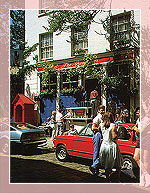
|
|
The Grenadier in Belgravia.
|


|
 |
The Grenadier in Belgravia was patronised by the Duke of Wellington.
|
|
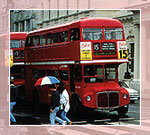
|
|
Double-decker bus.
|


|
 |
One of the best ways to see London (especially in the rain!) is from the top of a red double-decker bus.
|
|
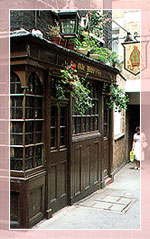
|
|
Ye Olde Mitre.
|


|
 |
Established in 1546, Ye Olde Mitre stands in secluded Ely Court.
|
|

|
|
A policeman of the Metropolitan force.
|


|
 |
A policeman of the Metropolitan force. The colloquial name of 'bobby' derives from Sir Robert Peel, Victorian statesman.
|
|





